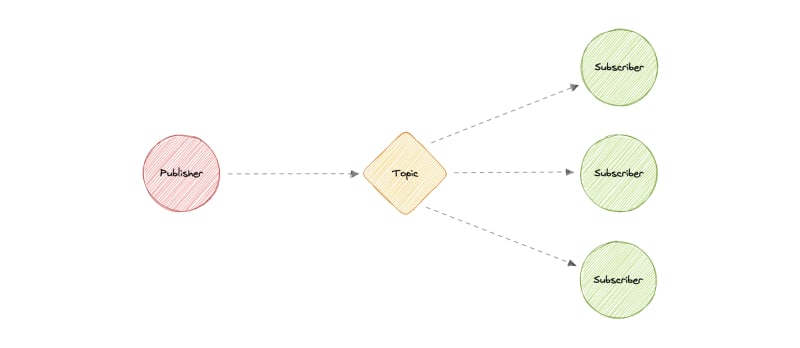Similar to a message queue, publish-subscribe is also a form of service-to-service communication that facilitates asynchronous communication. In a pub/sub model, any message published to a topic is pushed immediately to all the subscribers of the topic.
The subscribers to the message topic often perform different functions, and can each do something different with the message in parallel. The publisher doesn't need to know who is using the information that it is broadcasting, and the subscribers don't need to know where the message comes from. This style of messaging is a bit different than message queues, where the component that sends the message often knows the destination it is sending to.
Working
Unlike message queues, which batch messages until they are retrieved, message topics transfer messages with little or no queuing and push them out immediately to all subscribers. Here's how it works:
- A message topic provides a lightweight mechanism to broadcast asynchronous event notifications and endpoints that allow software components to connect to the topic in order to send and receive those messages.
- To broadcast a message, a component called a publisher simply pushes a message to the topic.
- All components that subscribe to the topic (known as subscribers) will receive every message that was broadcasted.
Advantages
Let's discuss some advantages of using publish-subscribe:
- Eliminate Polling: Message topics allow instantaneous, push-based delivery, eliminating the need for message consumers to periodically check or "poll" for new information and updates. This promotes faster response time and reduces the delivery latency which can be particularly problematic in systems where delays cannot be tolerated.
- Dynamic Targeting: Pub/Sub makes the discovery of services easier, more natural, and less error-prone. Instead of maintaining a roster of peers where an application can send messages, a publisher will simply post messages to a topic. Then, any interested party will subscribe its endpoint to the topic, and start receiving these messages. Subscribers can change, upgrade, multiply or disappear and the system dynamically adjusts.
- Decoupled and Independent Scaling: Publishers and subscribers are decoupled and work independently from each other, which allows us to develop and scale them independently.
- Simplify Communication: The Publish-Subscribe model reduces complexity by removing all the point-to-point connections with a single connection to a message topic, which will manage subscriptions and decide what messages should be delivered to which endpoints.
Features
Now, let's discuss some desired features of publish-subscribe:
Push Delivery
Pub/Sub messaging instantly pushes asynchronous event notifications when messages are published to the message topic. Subscribers are notified when a message is available.
Multiple Delivery Protocols
In the Publish-Subscribe model, topics can typically connect to multiple types of endpoints, such as message queues, serverless functions, HTTP servers, etc.
Fanout
This scenario happens when a message is sent to a topic and then replicated and pushed to multiple endpoints. Fanout provides asynchronous event notifications which in turn allows for parallel processing.
Filtering
This feature empowers the subscriber to create a message filtering policy so that it will only get the notifications it is interested in, as opposed to receiving every single message posted to the topic.
Durability
Pub/Sub messaging services often provide very high durability, and at least once delivery, by storing copies of the same message on multiple servers.
Security
Message topics authenticate applications that try to publish content, this allows us to use encrypted endpoints and encrypt messages in transit over the network.
Examples
Here are some technologies commonly used for publish-subscribe:
This article is part of my open source System Design Course available on Github.
 karanpratapsingh
/
system-design
karanpratapsingh
/
system-design
Learn how to design systems at scale and prepare for system design interviews
System Design
Hey, welcome to the course. I hope this course provides a great learning experience.
This course is also available on my website and as an ebook on leanpub. Please leave a ⭐ as motivation if this was helpful!
Table of contents
-
Getting Started
-
Chapter I
-
Chapter II
-
Chapter III
- N-tier architecture
- Message Brokers
- Message Queues
- Publish-Subscribe
- Enterprise Service Bus (ESB)
- Monoliths and Microservices
- Event-Driven Architecture (EDA)
- Event Sourcing
- Command and Query Responsibility Segregation (CQRS)
- API Gateway
- REST, GraphQL, gRPC
- Long polling, WebSockets, Server-Sent Events (SSE)
-
Chapter IV
- …








Latest comments (0)